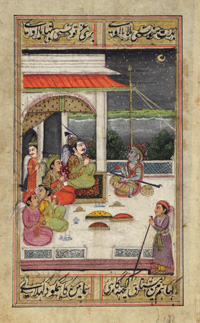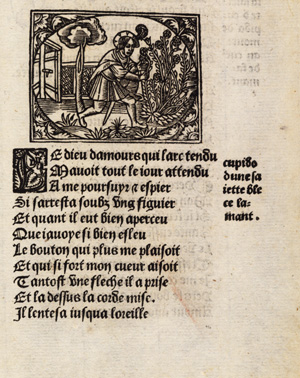| |
 |
| An illustration to the ‘Sihr ul-bayan’
(‘Enchanting story’) of Mir Hasan. Najm un-Nisa, disguised
in the grey ashes of an ascetic, entertains the court of the jinns.
MS Or. 2255, f.64. |
Storytelling is one of the oldest forms of entertainment, and many of
the earliest poems are cast as narratives. Legends and myths provide their
audiences with excitement and pathos, but also work as metaphors that
illuminate the human condition. The recurrence over millennia of particular
themes and stories in poetry demonstrates the enduring and renewable force
of archetypal narrative forms. The writers of medieval romances drew on
classical and Arthurian models to extol an idealised code of chivalric
behaviour in tales of adventure and courtly love, and the influence of
Greek, Roman, Celtic, Norse, and Native American mythology is visible
in the work of numerous modern poets.
Items on display:
MS Add. 2993: ‘Le roman de la rose’,
1354, open at ff.113v-114r. MS Or. 2255:
Mir Hasan, Sihr ul-bayan, c. 1785, displayed at ff.23r, 34r, 50r and 77v-78r.
MS Add. 8985/198: Robert Graves, ‘The
beggar maid and King Cophetua’, 1967.
|
 |
A version of ‘Le roman
de la rose’ printed in Paris in 1531, at the point in
Guillaume de Lorris’s section of the poem where the Lover
attempts to pluck the Rose: ‘The god of love, who all
day had stalked me with his bent bow, took up position by a
fig tree, and, when he saw that I had found the rosebud which
most pleased me and which so strongly gladdened my heart, swiftly
reached for an arrow, pulled the bowstring taut, and shot me
through the eye…’ SSS.41.21. (Printed document not
on display.) |
|
|
